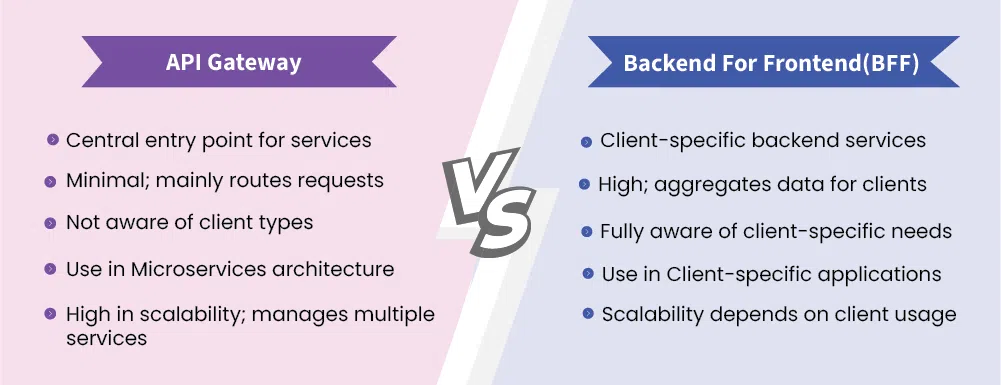API Gateway vs Backend For Frontend (BFF) (original) (raw)
Last Updated : 09 Oct, 2024
This article examines the differences and similarities between API Gateway and Backend For Frontend (BFF) patterns. Both architectural patterns facilitate communication between clients and backend services but serve distinct purposes and scenarios.

API Gateway vs Backend For Frontend (BFF)
Table of Content
- What is an API Gateway Pattern?
- What is Backend For Frontend (BFF) Pattern?
- API Gateway vs. Backend For Frontend (BFF)
- Use Cases of API Gateway Pattern
- Use Cases of Backend For Frontend (BFF) Pattern
What is an API Gateway Pattern?
An API Gateway is a server that acts as a single entry point for clients to access multiple backend services. It centralizes request management, routing, and various cross-cutting concerns such as authentication and logging.
Characteristics of API Gateway:
- **Request Routing: Directs incoming requests to the appropriate microservices based on the request URL and parameters.
- **Authentication and Security: Enforces security measures such as API keys or OAuth tokens to protect backend services.
- **Load Balancing: Distributes incoming requests among multiple instances of services to optimize performance and ensure high availability.
- **Protocol Translation: Converts requests from one protocol (e.g., HTTP) to another (e.g., WebSocket) to facilitate communication between clients and services.
- **Rate Limiting: Controls the number of requests a client can make within a specified timeframe to prevent abuse and ensure fair resource allocation.
What is Backend For Frontend (BFF) Pattern?
The Backend For Frontend (BFF) pattern involves creating dedicated backend services tailored for specific frontend applications. Each BFF serves as an intermediary between the frontend and various backend services, optimizing communication and data retrieval.
Characteristics of BFF:
- **Client-Specific APIs: Each BFF is designed to cater to the unique needs of its corresponding frontend application, reducing unnecessary data transmission and improving performance.
- **Optimized Data Handling: By aggregating data from multiple backend services, a BFF minimizes the number of requests made by the client, improving response times.
- **Ease of Development: Frontend teams can develop and iterate on their BFF independently, reducing dependency on backend changes.
- **Flexibility: BFFs can evolve alongside their respective frontend applications, allowing for rapid development cycles and tailored updates.
API Gateway vs. Backend For Frontend (BFF)
Below are the differences between API Gateway and Backend For Frontend (BFF):
| Feature | API Gateway | Backend For Frontend (BFF) |
|---|---|---|
| **Purpose | Central entry point for services | Client-specific backend services |
| **Data Aggregation | Minimal; mainly routes requests | High; aggregates data for clients |
| **Client Awareness | Not aware of client types | Fully aware of client-specific needs |
| **Use Cases | Microservices architecture | Client-specific applications |
| **Scalability | High; manages multiple services | Dependent on client usage |
| **Security | Centralized security measures | Security measures tailored per client |
Use Cases of API Gateway Pattern
Below are the use cases of API Gateway pattern:
- **Microservices Management: An API Gateway can simplify the architecture by providing a unified entry point for various microservices, making it easier to manage and secure complex systems.
- **Security Management: Organizations can implement authentication and authorization at the API Gateway level, ensuring that only legitimate requests reach backend services.
- **Analytics and Monitoring: The API Gateway can collect metrics and logs for incoming requests, providing insights into usage patterns and potential issues.
- **Rate Limiting **and Quotas: To manage API consumption, the gateway can enforce rate limits and quotas, preventing abuse and ensuring service availability for all users.
Use Cases of Backend For Frontend (BFF) Pattern
Below are the Use Cases of Backend For Frontend (BFF) Pattern:
- **Mobile Applications: A BFF can tailor responses specifically for mobile clients, optimizing data payloads to minimize latency and improve the user experience.
- **Single Page Applications (SPAs): Different SPAs can have their own BFFs, allowing for custom APIs that meet their specific needs, which leads to better performance and efficiency.
- **Multiple Client Types: Organizations that serve different client types (e.g., web, mobile, IoT) can create multiple BFFs, each designed to cater to the unique requirements of their respective clients.
- **Rapid Prototyping: BFFs enable frontend teams to quickly iterate and test new features without affecting the backend, accelerating the development process.
Conclusion
Both the API Gateway and Backend For Frontend patterns are essential components in modern software architecture. While an API Gateway acts as a centralized entry point for various backend services, the BFF pattern provides tailored experiences for different client types.
Understanding their distinct roles helps organizations design efficient, scalable systems that enhance user experience and facilitate rapid development.